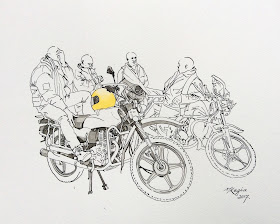Cyrus Kabiru at his new art studio in Machakos County modeling a pair of his C-Stunners (photo by MG)
CYRUS’ ART FILLS ONE WHOLE GALLERY ROOM AT ZEITZ MUSEUM OF CONTEMPORARY AFRICAN ART (MOCAA)
BY
Margaretta wa Gacheru (posted September 29, 2017)
When Mark
Coetzee came to Kenya to confer with art aficionados about which artists they’d
recommend to include in the opening exhibition of the Zeitz Museum of
Contemporary African Art (MOCAA), he were amazed to find the lists he received didn’t
include Cyrus Kabiru.
The Zeitz
MOCAA curator and executive director had just seen Cyrus’ one man exhibition “The
End of the Black Mamba’ at the SMAC Gallery in Cape Town and already knew his
C-Stunner specks were going to part of the grand opening [on September 15th]
of the world’s largest museum of contemporary
African and Diasporan art.
But if
Coetzee was surprised, Cyrus was not. “Art is war and I’ve been in this battle
for quite some time,” said one of only two Kenyan artists (Wangeci Mutu is the
other) whose artworks were not only selected to be in the grand opening of what
had once been a nine-story grain silo but now, after a grandiose overhaul, is
the leading cultural attraction of the V&A Waterfront, one of the most
popular entertainment centres in Cape Town.
Cyrus with Jochen Zeitz (left) of the Zeitz MOCAA and an art collector
Cyrus’s now
world-renowned C-stunners sculptures were also bought to become part of the
German entrepreneur Jochen Zeitz’s permanent art collection. “Twenty - four
C-stunners are now in the museum’s permanent collection,” Cyrus told the Business
Daily the same night he came back from Cape Town. “They also got twenty - four
photographs of the C-Stunners.”Cyrus with Jochen Zeitz (left) of the Zeitz MOCAA and an art collector
At the
opening, only the photographs had been hung in one second floor gallery. “They
said they hadn’t had time to put up the glasses before the opening but they’ll
do it,” he added.
But since
his photographs occupy the whole room, Cyrus isn’t disappointed. Zeitz MOCAA
also didn’t buy his quirky bicycle sculpture. But that didn’t bother him either
since the bikes, made with the same meticulous craftsmanship, creativity and originality
of design as his specks, were on display at SMAC. That’s the gallery that Cyrus
has been affiliated with since 2014 when he first went to Cape Town to be part
of a Guinness ad campaign called ‘Made of Black’ and SMAC’s curator... saw his C-Stunner
specks.
SMAC’s
current exhibition, entitled ‘Pandashuka’, has already been critiqued by some
of the world’s leading art critics. Writers like Mark Spiegler who’s been
ranked among the top 25 most influential individuals in the global art world have
praised Cyrus’ new show to the hilt.
But just as
his specks are not really spectacles, his bicycles are not really bikes. Both
begin with those basic concepts but then they’re reconfigured into highly
original sculptures made out of either junk that Cyrus collects or ordinary
utility items like spoons and forks, auto or bicycle spare parts, lids from
kitchen bottles and cans, and metallic wires, some store-bought, others
procured by sundry means.
He can
incorporate almost anything into his ingenious works which are all one-of-a-kind.
But his art hasn’t always been highly valued or even understood, especially by
family members who conventionally believed he was wasting his life doing art.
(Which is one reason why he describes art as ‘war’ which has many battle
fronts.) But his family has largely changed their tune now that they’ve seen
how he’s managed to earn a good living, start a family and invest his earnings
well.
Getting his
art bought by Zeitz MOCAA might seem like a rare pinnacle of success for this
32 year old artist. But actually, Cyrus’s art has been exhibited and sold to
leading public institutions and private collections all over the world. Even
so, he admits it’s been a long journey to arrive at where he is today. The need
to stay focused and concentrate on his art is one reason why he moved out of
his studio at Kuona Trust two years back and into his own solo studio in
Machokos County. “I’d like to expand the studio into a residence where artists
can come from all over and work for some time,” he says.
Some of the junk Cyrus collects to use in his art works. It's in his new studio in Machakos county
‘My friends
call my place the ‘Away Studio’ since it seems far away to them, but I prefer
to be on my own and keep a low profile as well,” he adds.
Cyrus isn’t the
only local artists who’s moved out of institutional settings like Kuona Trust
and GoDown Art Centre in recent times. “I’m feeling the local art scene is
changing rapidly. Some of it is sad since the institutions seem to be losing
ground. But I think it’s good that artists are branching out and becoming more
independent. It’s better for them in the long run.”



























